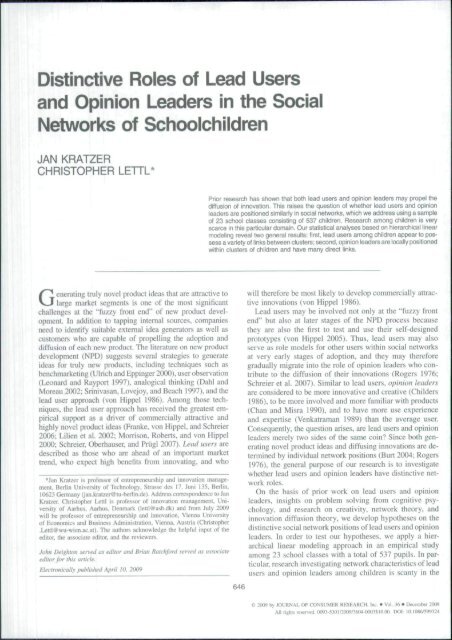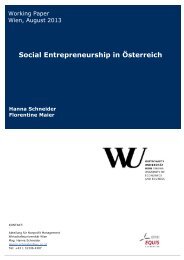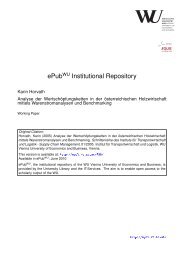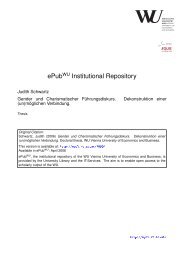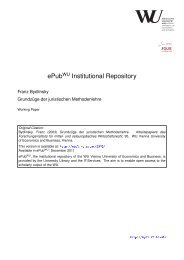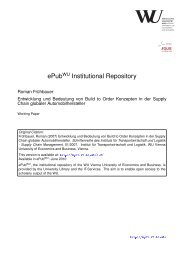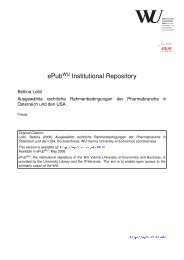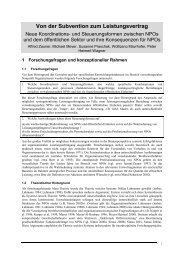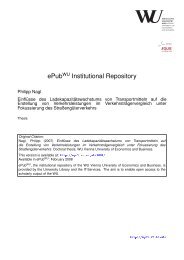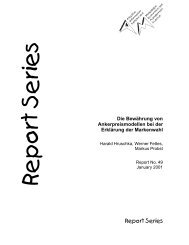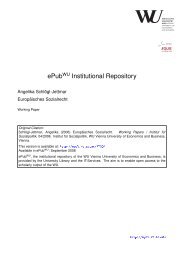Download - ePub WU
Download - ePub WU
Download - ePub WU
You also want an ePaper? Increase the reach of your titles
YUMPU automatically turns print PDFs into web optimized ePapers that Google loves.
Distinctive Roies of Lead Users<br />
and Opinion Leaders in the Social<br />
Networks of Schoolchildren<br />
JAN KRATZER<br />
CHRISTOPHER LETTL*<br />
Prior research has shown that both lead users and opinion leacters may propel the<br />
diffusion of innovation. This raises the question of whether lead users and opinion<br />
leaders are positioned similarly in social networks, which we address using a sample<br />
of 23 school classes consisting of 537 children. Research among children is very<br />
scarce in this particular domain. Our statistical analyses based on hierarchical linear<br />
modeling reveal two general results: first, lead users among children appear to possess<br />
a variety of links between clusters; second, opinion leaders are locally positioned<br />
within clusters of children and have many direct links.<br />
Generating truly novel product ideas that are attractive to<br />
large market segments is one of the most significant<br />
challenges at the "hi/.zy front end" of new product development.<br />
In addition to tapping internal sources, companies<br />
need to identify suitable external idea generators as well as<br />
customers wbo are capable of propelling the adoption and<br />
diffusion of each new product. The literature on new product<br />
development (NPD) suggests several strategies to generate<br />
ideas for truly new products, including techniques such as<br />
benchmarketing (Ulrich and Eppinger 20(X)). user observation<br />
(Leonard and Rayport 1997). analogical tbinking (Dahl and<br />
Moreau 2002; Srinivasan, Lovejoy. and Beach 1997), and tbe<br />
lead user approach (von Hippel 1986). Among those techniques,<br />
the lead user approach has received tbe greatest empirical<br />
support as a driver of commercially attractive and<br />
highly novel product ideas (Franke, von Hippel. and Schreier<br />
2006; Lilien et al. 2002; Morrison. Roberts, and von Hippel<br />
2000; Scbreier. Oberbauser. and Prügl 2007). Lead users are<br />
described as those wbo are ahead of an important maiket<br />
trend, who expect high benefits from innovating, and wbo<br />
*Jan Kralzer is professor of entrepreneurship and itinovation managemeni.<br />
Berlin University of Technology. Strasse des 17. Juni 135. Berlin.<br />
10623 Germany (jan,krauer@tu-berlin,de). Address correspondence to Jan<br />
Kratzer- Chrisiopher Letil is professtir of innovation managcmeni. University<br />
of Aarhus. Aarhus, Denmark (letll@asb,dk) and from July 2{X)9<br />
will be professor of enirepreneurship and innovation, Vienna Univensily<br />
of Economics and Business Administration. Vienna. Austria (Christopher<br />
.Letti@wu-wien.ai;.at), The authors acknowledge the helpful input of the<br />
ediEor. the associate editor, and the reviewers.<br />
John Deighton served as editor and Brian Ratchford sen-ed as associate<br />
editor for this article.<br />
Electronically puhli.'ihed April 10, 2009<br />
will therefore be most likely to develop commercially attractive<br />
innovations (von Hippel 1986).<br />
Lead users may be involved not only at tbe "fuzzy fi-ont<br />
end" but also at later stages of the NPD process because<br />
they are also the first to test and use their self-designed<br />
prototypes (von Hippel 2005). Thus, lead users may also<br />
serve as role models for otber users witbin social networks<br />
at very early stages of adoption, and they may therefore<br />
gradually migrate into the role of opinion leaders who contribute<br />
to tbe diffusion of tbeir innovations (Rogers 1976;<br />
Schreier et al. 2(XJ7). Similar to lead users, opinion leaders<br />
are considered to be more innovative and creative (Cbilders<br />
1986). to be more involved and more familiar witb products<br />
(Cban and Misra 1990). and to have more use experience<br />
and expertise (Venkatramun 1989) tban tbe average user,<br />
Consequently, the question arises, are lead users and opinion<br />
leaders merely two sides of the same coin? Since bodi generating<br />
novel product ideas and diffusing innovations are determined<br />
by itidividual network positions (Burt 2004; Rogers<br />
1976). tbe general purpose of our research is to investigate<br />
whether lead users and opinion leaders have distinctive network<br />
roles.<br />
On the basis of prior work on lead users and opinion<br />
leaders, insigbts on problem solving from cognitive psychology,<br />
and researcb on creativity, network theory, and<br />
innovation diffusion theory, we develop hypotheses on the<br />
distinctive social network positions of lead users and opinion<br />
leaders. In order to test our hypotheses, we apply a hierarchical<br />
linear modeling approach in an empirical study<br />
among 23 school classes with a total of 537 pupils. In particular,<br />
research investigating network characteristics of lead<br />
users and opinion leaders among children is scanty in the<br />
646<br />
e 2009 by JOURNAL OF CONSUMER RESEARCH, Inc • Vol. .16 • December 20O9<br />
All rights reserved 0O93-53UI/2O09/36Ü4-IXI03S10.0Ü. DOI: 10.1086/59^324


